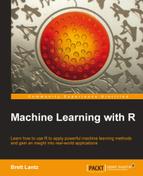Machine learning, at its core, is concerned with algorithms that transform information into actionable intelligence. This fact makes machine learning well-suited to the present day era of Big Data. Without machine learning, it would be nearly impossible to keep up with the massive stream of information.
Given the growing prominence of R—a cross-platform, zero-cost statistical programming environment—there has never been a better time to start using machine learning. R offers a powerful but easy-to-learn set of tools that can assist you with finding data insights.
By combining hands-on case studies with the essential theory that you need to understand how things work under the hood, this book provides all the knowledge that you will need to start applying machine learning to your own projects.
Chapter 1, Introducing Machine Learning, presents the terminology and concepts that define and distinguish machine learners, as well as a method for matching a learning task with the appropriate algorithm.
Chapter 2, Managing and Understanding Data, provides an opportunity to get your hands dirty working with data in R. Essential data structures and procedures used for loading, exploring, and understanding data are discussed.
Chapter 3, Lazy Learning – Classification Using Nearest Neighbors, teaches you how to understand and apply a simple yet powerful learning algorithm to your first machine learning task: identifying malignant samples of cancer.
Chapter 4, Probabilistic Learning – Classification Using Naive Bayes, reveals the essential concepts of probability that are used in cutting-edge spam filtering systems. You'll learn the basics of text mining in the process of building your own spam filter.
Chapter 5, Divide and Conquer – Classification Using Decision Trees and Rules, explores a couple of learning algorithms whose predictions are not only accurate but easily explained. We'll apply these methods to tasks where transparency is important.
Chapter 6, Forecasting Numeric Data – Regression Methods, introduces machine learning algorithms used for making numeric predictions. As these techniques are heavily embedded in the field of statistics, you will also learn the essential metrics needed to make sense of numeric relationships.
Chapter 7, Black Box Methods – Neural Networks and Support Vector Machines, covers two extremely complex yet powerful machine learning algorithms. Though the mathematics may appear intimidating, we will work through examples that illustrate their inner workings in simple terms.
Chapter 8, Finding Patterns – Market Basket Analysis Using Association Rules, exposes the algorithm for the recommendation systems used at many retailers. If you've ever wondered how retailers seem to know your purchasing habits better than you know them yourself, this chapter will reveal their secrets.
Chapter 9, Finding Groups of Data – Clustering with k-means, is devoted to a procedure that locates clusters of related items. We'll utilize this algorithm to identify segments of profiles within a web-based community.
Chapter 10, Evaluating Model Performance, provides information on measuring the success of a machine learning project, and obtaining a reliable estimate of the learner's performance on future data.
Chapter 11, Improving Model Performance, reveals the methods employed by the teams found at the top of machine learning competition leader boards. If you have a competitive streak, or simply want to get the most out of your data, you'll need to add these techniques to your repertoire.
Chapter 12, Specialized Machine Learning Topics, explores the frontiers of machine learning. From working with Big Data to making R work faster, the topics covered will help you push the boundaries of what is possible with R.
